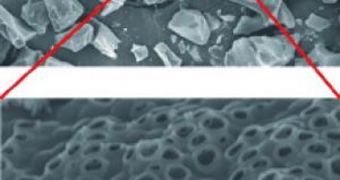A group of researchers at the Ulsan National Institute of Science and Technology (UNIST), in South Korea, announces the development of a new type of anode material for lithium-ion (Li-Ion) batteries.
This component makes use of nanotechnology to boost the performances of conventional anodes used in this class of batteries. Given their popularity, lithium-ion batteries are constantly being researched.
What experts around the world are focusing on at this point is developing methods of allowing these devices to store more energy, release it faster, and charge at much higher speeds than currently possible.
Li-Ion batteries are the power sources of choice for most electronics companies today. If you have a cell phone, smartphone, tablet computer, laptop or mp3 player, chances are that they are powered by such a device. However, in spite of all researches, their ability to hold energy is still limited.
According to the UNIST group, constructing an anode out of nanomaterials – rather than the conventional material graphite – provides as much as three times the charge of conventional batteries.
A 300 percent boost in energy storage would allow smartphones to need charging just once every other week, and would give laptops autonomies of as much as 10 to 12 hours at the least energy-effienct power settings, Technology Review reports.
The nanotubes the South Korean team constructed are made out of germanium nanotubes. The material allows an anode to charge or discharge five times faster than a standard, silicon-based counterpart.
At the same time, these anodes can be put through twice as many reload cycles than silicon-based ones. In this sense, they are right on par with the performance levels of graphite-based anodes. In all, the germanium-based anodes can endure up to 400 load/reload cycles.
“These anodes meet the practical requirements of lithium-ion cells,” says UNIST researchers and study leader Jaephil Cho. He says that his group collaborated with scientist from Korean company LG Chem, which is the one that produces the batteries used by General Motors in its Chevy Volt.
Details of the new investigation will appear in an upcoming online issue of the esteemed international journal Angewandte Chemie. The South Korean team is not limited to using germanium. It is currently engaged in constructing anodes based on silicon nanoparticles as well.
“The company is looking for a breakthrough technology using both silicon and germanium materials for lithium-ion battery anodes,” Cho says of LG Chem. The firm is looking to establish a name for itself in the Li-Ion battery market.
“Germanium is an abundant element, and the current price is maintained by the lack of demand. A hurdle for using germanium in real batteries is cost, but once big battery makers want to use it as an alternative candidate for [anodes], I believe its cost will drop,” Cho concludes.

 14 DAY TRIAL //
14 DAY TRIAL //